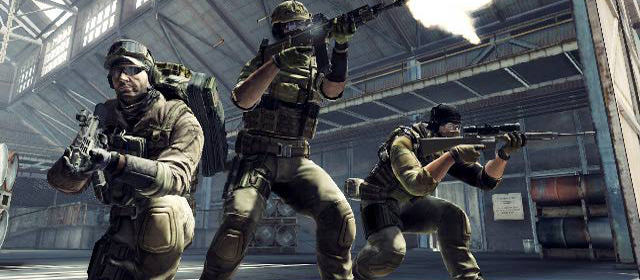Attending a Ghost Recon preview day, our very own Rik Wortman managed to get the chance to sit down with three of Ghost Recon: Future Soldier’s prominent team members, Eric Couzian – Game Director, Jean-Marc Geffroy – Creative Director and Adrien Lacey – IP Development Director, who answered questions and shared their development thoughts on the progress of the upcoming Ghost Recon: Future Solder.
The cover swap system you have going for this game is one I know people have wanted implemented in games like Call of Duty, and they tried it a bit with their online third person mode. Personally, it didn’t work at all, so what was your plan when attempting it yourselves?
Adrien Lacey: The basic cover view has always been part of the Recon series, and that cover swap puts you into the heart of the action. It gives you that intensity and gives you that smart experience, allowing you to jump, pop up, shoot, duck, move, jump, pop up, so it sets the tone and the beat to the game.
Eric Couzian: Our first goal was to say “Let’s concentrate on the main character, and lets see when something happens, I want good cover and, no wait! I need something else.” The player has to react immediately, that’s why the main cover system has five hundred animations just for the main character, and a lot of these animations allow us to be sure that each time you have an input you can do what you want, and you don’t need to wait until the end of a piece of animation to join in the next one. That was the first objective. The second one was more game orientated, we wanted to be sure that when you were in cover, you could do all things possible, such as a peek, or what we call a neck standard peek, when you look behind a wall, but can go back to cover quickly, jump over the cover quickly as well. But at the beginning we felt it was missing something, when you’re under fire, what you want is to cover yourself, and when you know your cover isn’t the right one, you want to move very quickly to another one, and this is something where games don’t go fast enough, and when you see special forces, the speed they have when they just move, we need to have a good system like that.
Adrien Lacey: When you’re getting shot at it’s amazing how you want to find some cover, that’s effective, and that’s definitely something we got back from the special forces guys, and something we’ve been working on with the military guys, they’re like “I’m here, I’m gonna shoot, but if I take fire I need to get there for a better angle to think about what I’m doing, and my team mates and me are going to move very quickly, point to point.” I think that’s what cover swap give you, it’s dynamic, it adds that speed and adrenaline.
Jean-Marc Geffroy: I tell you what we wanted was to have this phase to remain undetected, but also to come close to the enemies and surprise them. But when the gunfight is open you can use the same way to defend team mates or get new cover, because the previous cover is now in danger. So this mechanic works the same way.
Eric Couzian: But you can also notice when you are cover swapping in recon, it’s the exact same speed as when you are cover swapping in combat.
Adrien Lacey: It’s also the level of detail, those little moves you see when they put their hands up to warn, one of those little details you get being OTS, and seeing how the camera drops in and feel the battlefield, feeling that heated fire fight, that’s what Ghost Recon offers players that other shooters don’t necessarily touch upon.
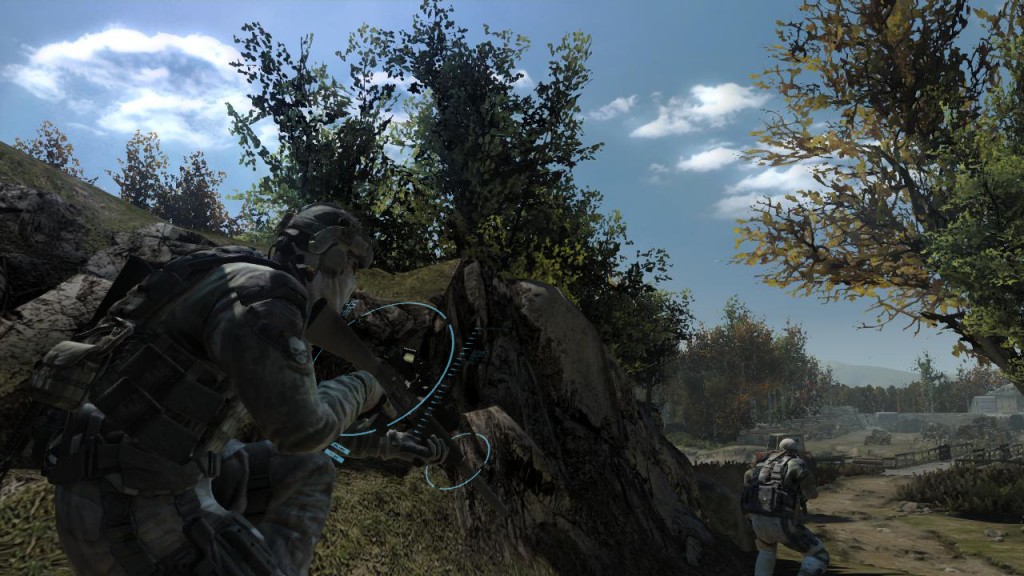
With the tagging system, when I first saw it I thought “This could make the game slightly too easy, I’ll just send my team in to do the work and sit back.” So was there any kind of barriers you had to overcome when it came to a difficulty between styles?
Eric Couzian: Yes, actually, with the gameplay mechanic, we tried to think logically, which is, I use my teamates a lot, so if I tag enemies, they have to shoot, therefore they’re taking more risk, so my teamate has risked himself for me, so if you use them too much, they’ll be shot, and you have to revive them, if you want. But it’s a kind of balance which is really used a lot, you ask them to take risks, but eventually they’ll be killed. The other is the way that the AI is programmed according to the threat, it doesn’t react according to the player, and it was a huge job for us because we said “Right, we want to do a campaign full of co-op, so I should not be player centric, but I would say ‘my life’ centric”, so the player tries to find the safest place for the group and their line of sights not according to what the player wants, but according to the threat presented.
Adrien Lacey: And the situation itself.
Eric Couzian: So you use your team mates to find the big threats so the enemy can be shot.
When I was playing the last level of the demo, you had the sniper rifle equipped with heat seeking bullets. Now, I’ve never seen this, but was told that it’s something being developed by the US at the moment.
Adrien Lacey: Yeah, intelligent bullets, that sort of thing.
So are you keeping up to date, quite literally, because the game’s going to be released and those bullets aren’t even available yet in real life, so were you keeping up to date with technology the entire time?
Adrien Lacey: Yeah, we have our authenticity specialist who worked with the special forces anyway, there’s also different companies who develop future technologies for military purposes, so we were always looking very closely at that, and paying very close attention to it. We have one guy who is dedicated to the detail of what’s coming out. It’s like the optical camouflage as well, obviously Cornell University have been doing work on fibreoptics, to show how they can curve light, so that’s a real technology.
We… pull it a little bit, because it’s not on the field, but I remember when we did GR:AW on the Crosscom, that was something noone had really seen on TV or anywhere, and the whole point of Crosscom was so you could look at a map app, for example, while still having an eye on the battlefield, for situational awareness, and when we did the Crosscom, it’s funny that 2 or 3 years later when you’re watching CNN and stuff, you’ve got all these guys with these gadgets on and you’re like “What’s that?” and I was like “Yeah, it’s Crosscom!” Same with your mobile phones, so we find a way to take it further, because now with your mobile phone you look around, you get augmented reality, so your Crosscom does work like that, it’s just an overlay on the eye, so it’s not intrusive, it means you still have full awareness of what’s going on, because it’s very important when your getting shot at, and when you’re not getting shot at! So yeah, we spend a lot of time with that, those heat seeking bullets are the intelligent bullet of the future, so… that’s why everything’s modular on the gun now, when you see Gunsmith and spread it out, you can adapt it to the way you want, and have your gun the way you want it. Now we’re looking more of the smart shooter, smart shooter, smart players.
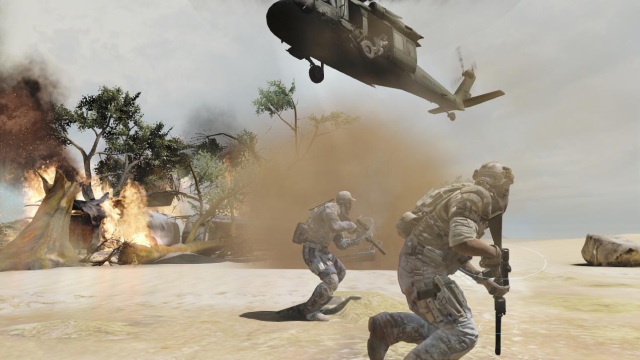
Definitely, obviously it’s called ‘Future Soldier’, but I was impressed with the fact it doesn’t seem like it would be ageing any time soon.
Adrien Lacey: Well I hope not! It goes so quickly.
I was really impressed. When it comes to field research on other shooters, did you look to see what was on the market, or coming out on the market, or did you just try to create a game that was fresh and new?
Adrien Lacey: I think the bottom line is, yeah, we play everything, we play shooters, we love them, that’s why we make them. I think the most important thing for us is that Ghost Recon had that next gen feel. Ghost Recon is a franchise that’s been around for ten years, and it’s very important to us, but we focused on Future Soldier as a seperate game, and what we want to put into the players hands. We don’t look and say “Can we do the same as them?” Yeah, we learn what they do and stuff like that, but we’re an over-the-shoulder shooter, a lot of the shooters that are out there are first person, so it’s a different experience. We were like the ‘smart shooter’, you go, you think about what you’re going to do, and that’s very special forces. They think about what they’re going to do before they do it, and we want to give players that feel and vibe to be precise before you shoot. I’m thinking about what I’m doing, and it’s still fast, but it empowers me differently, not just [Adrien makes the noise of spraying bullets]. Which can be fun! This is just a little more deep, it’s got a little more depth to it. There’s a lot of shooters out there now, and this is a way of giving players something different.
The four special ops guys you worked with; how long did you work with them for?
Adrien Lacey: From the very beginning. Well, we worked with one guy, and used him as the main player, so had one key team member that spends time with us. We did like bootcamps and stuff so they could show us situations and walk us through, because it’s that as well, just that learning curve, just imagine you’ve never been in that situation, like some of our developers. The way they think, they way they move is very interesting to understand. It’s funny, innovation is often based in reality, we find that quite strong, fantasy can sometimes lead you astray, but when you focus on reality, it can actually trigger innovations, and that’s an interesting dynamic. So when we did the bootcamp, for example, they put us in situations, like civilians; we were only doing airsoft, light fire, nothing serious, but we were put into a situation where we were thinking together.
They put us in little teams, and it’s funny; you know those little anecdotes like “Bravo 2, come in” and the spec guy was like “Look, you’re getting shot at, you grab the guy and you fucking run.” They don’t sit there saying ‘Bravo 1, you’re in danger’, that’s Hollywood to a certain extent. He says “No, you just do it, you get it done.” and that’s really their spirit. Even civilians, they were giving us situations like “you’re in a hotspot, there’s women, children, adults, loads of people around. Who’s the enemy?” One of the biggest things, one of the advantages we have is we aim at what we shoot at. We don’t just start mowing people down. And that’s where we got the Intel Grenade that will flash up your enemies in crowds. There’s also when they move as a squad, how they react to each other, plan how one guy will focus fire there, another will grab attention allowing me to flank. It’s those kinda devices that are core to this game. We have civilians running and screaming at you, so you try doing that while you’re getting shot at, ‘Cause the enemy doesn’t care who they shoot. That’s the whole point, you have to be careful, but they don’t. It adds interesting dynamics in terms of gameplay.
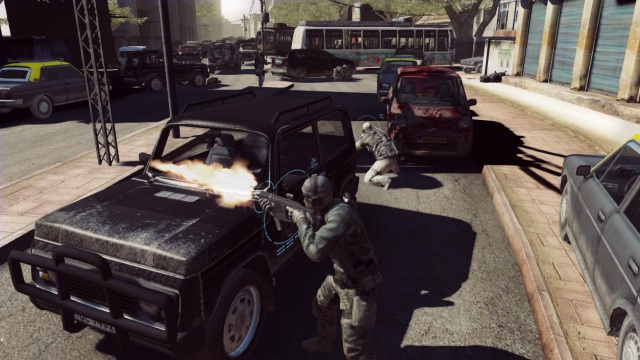
So when you said Hollywood, and things have been dramatised in a way, do you think how actors who are playing a role try to put themselves in that situation, do you think that’s the future of game development, that people will be putting themselves in those positions, maybe not so much fantasy…
Adrien Lacey: Yeah, definitely. I think here, even the way we approached it, you have a lot of people who say “Yeah, we spoke to this person and that person.” but here you get the way the team acts together, you get that feel and the trained AI with the motion capture and animations, you get a vibe that they know who you are, so you get a personality to the guy, a 3D character, you get more characterisation, and I think that you get that from talking to the real deal, and it’s what Ghost Recon has always been founded on, it’s what Clancy’s always been a part of. That plausible story working with the real people to give that influence.
One of the best examples is where originally we were pushing technology, pulling technology to give all these gadgets, and it was then we sort of brought the Spec Ops back into life, we said “How do you use technology?” and he said “Yeah we use a lot of technology, but function is more important for us, it’s about the gun shooting what we want it to shoot.” And he gives us an example using GPS, he goes “Look, we’ve had GPS for years. We get dropped into a hotspot, but then just like when you’re driving around, we’re on the wrong side of the fucking building. The fights on the other side, what do you do? You don’t just say ‘The GPS says I’m here, I should be killing guys!’, you can’t do that, so we have to think about it and have to act on it. We go ‘Fuck it’, okay, we’re roughly in the right place, but we have to move.’” and I think that’s very true, the tool has to be a function, not just a problem solver to everything. You still have the man and that’s what makes those guys incredible. It is what makes it special.
Was the game always going to be focussed on co-op, a squad moving through, or was there a point where you were alone?
Adrien Lacey: No, I think we always wanted to do co-op, we think in that squad mechanic, but taking out the oral system from the previous Ghost Recon was very important to us, we wanted to simplify to give that smart shooter sort of mentality. So the squad based combat is very important to us, because it adds that depth of characters, because you have to react to each other, it’s that sort of brotherhood type of feel. So it’s always been an idea to have a squad and a four player co-op that you can play in the campaign, and you can’t add it at the end, that’s what a lot of games will do as a separate mode, but you have to build it from the ground up if you’re going to do a seamless co-op. You can’t do it after, or as an after thought because the maps aren’t right, your level design is off, it’s too complicated. So we wanted to do it from the start.
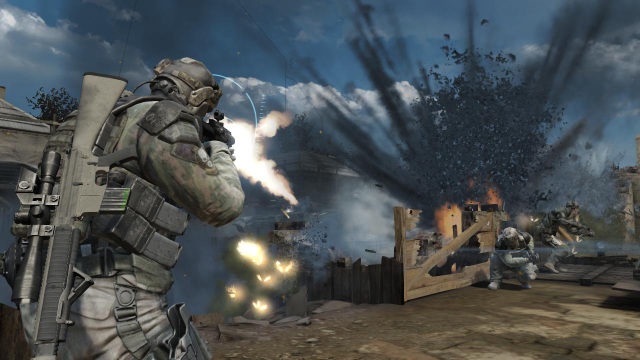
I mean, there have been games in the past that say “You can do it on your own, or as co-op!” but the second someone else comes in, it gets complicated, and you’re taking out the same enemy…
Adrien Lacey: Definitely, the balance is complex, and we’ve learnt over the years as well from those kinds of situations, it’s why we took our time with future soldier it’s because things like that are important, especially to get that real experience, it’s key.
I was really impressed, this co-op is so smooth, it shows and I had to ask if it had been considered as a single player just to confirm my own doubts.
Adrien Lacey: I think that depth for the game, it really is key. I think now, people expect that, I think that’s where games go now, it’s that interactivity with other players, with your team mates and with the AI. I think that’s what we’re getting, that’s what we’re starting to build, and get better and better at, what we’ll see mid to end generation consoles. I think it’s interesting how we’ve learnt as well, it’s always a learning experience, we’ve learned a lot, and we know what we want. We have the more adversarial mulitplayer modes that you guys haven’t seen yet, but there’s also that, which takes that spirit one step further.
One last question that makes some people cringe; are you thinking about taking it to the Nintendo side, what with the Wii U, its HD visuals and interesting controller?
Adrien Lacey: Nintendo?! Nintendo and Wii U are stuff we look at, we’ve been working with a Nintendo for years now. But Ghost Recon is coming out in May, before the Wii U, so it won’t be around for that. But I think the Wii U is interesting, because it’s going to change the experience, I think the controller and the utilisation of the pad is very interesting. I think when you see with Gunsmith and Kinect, it’s something we look at, how players react in different ways with their game. So it’s always something we look at, from a general point of view.
Well, I think that’s everything. Thank you very much!
Adrien Lacey: No problems, thank you!
For even more Ghost Recon information, check out GodisaGeek’s Ghost Recon: Future Soldier preview!


